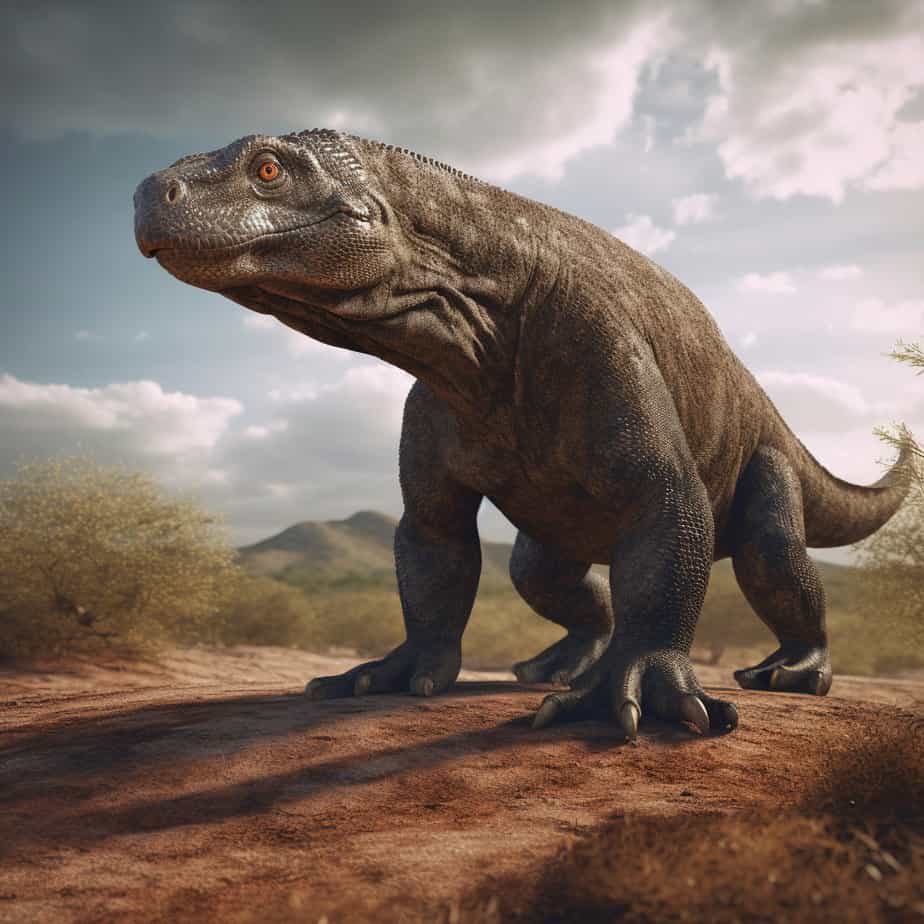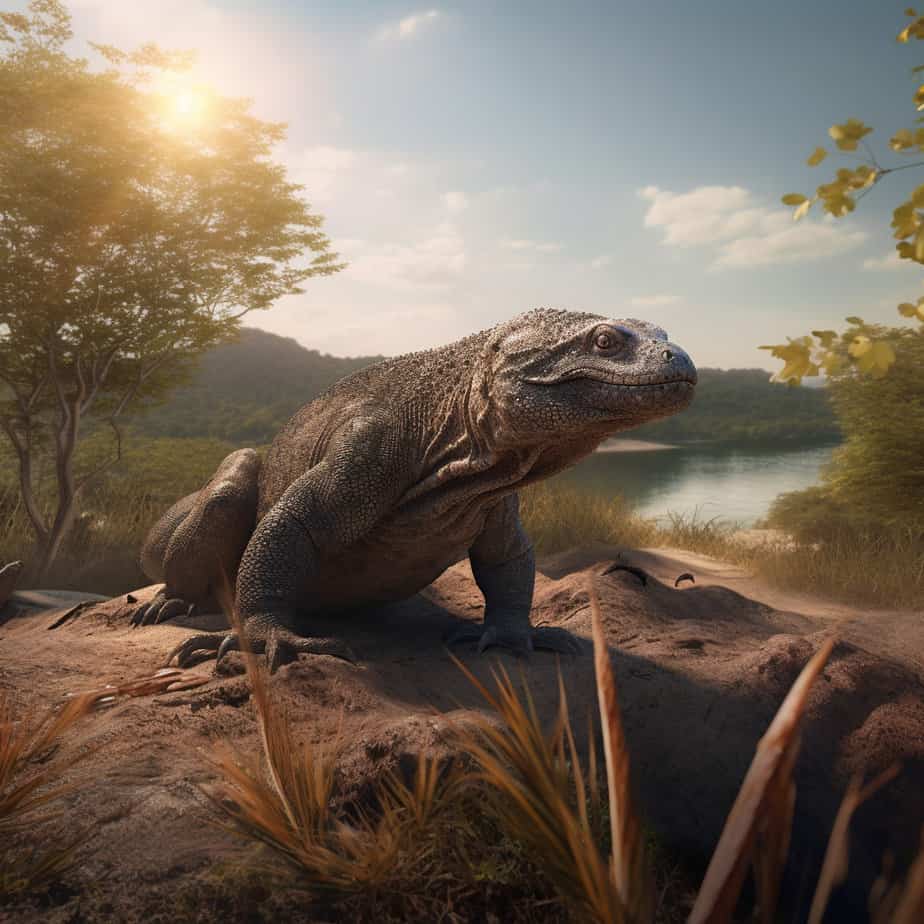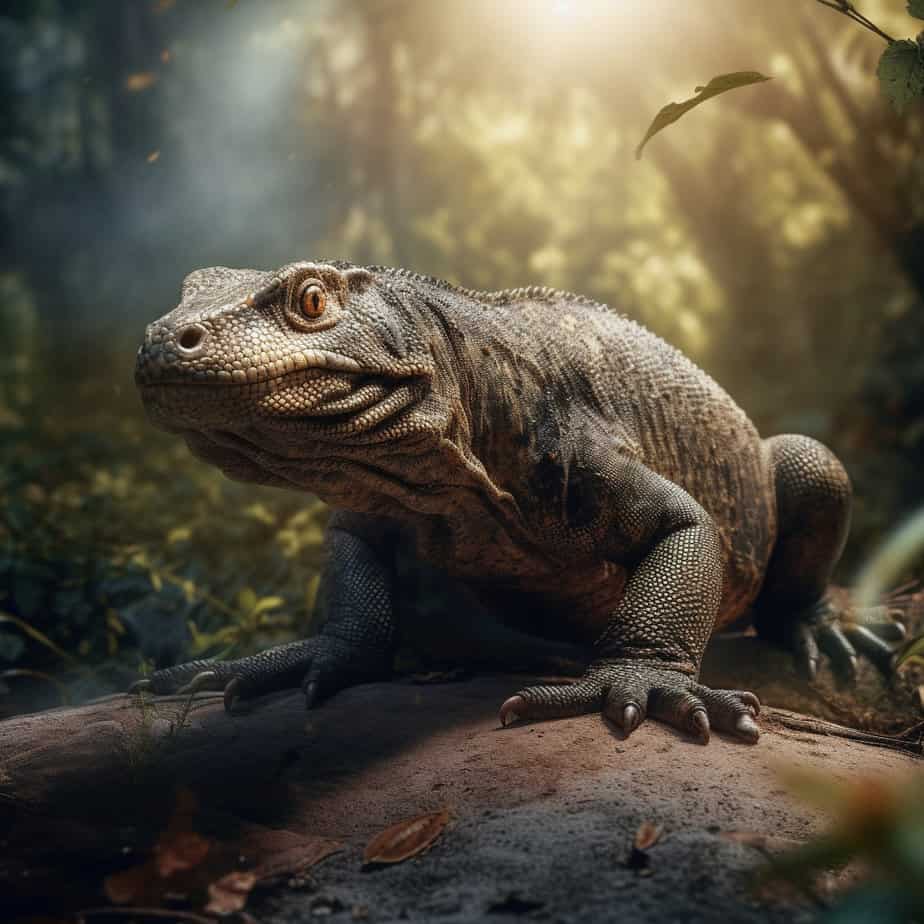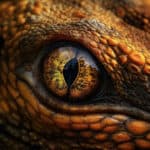Alligators and Komodo dragons are two fascinating creatures that often capture our imagination with their sheer size and power. While both are formidable predators in their own right, they belong to different taxonomic families and inhabit different parts of the world. In this article, we will explore the similarities and differences between alligators and Komodo dragons, shedding light on their physical characteristics, habitats, behavior, and hunting techniques. So, let’s dive into the world of these incredible reptiles and discover what sets them apart.
Key Takeaways
- Alligators and Komodo dragons are both large reptiles, but they belong to different families.
- Alligators are found in freshwater habitats in the Americas, while Komodo dragons are native to the Indonesian islands.
- Alligators have a broader snout and are primarily carnivorous, feeding on fish, birds, and mammals. Komodo dragons have a narrower snout and are known for their scavenging behavior.
- Alligators are generally less aggressive towards humans, while Komodo dragons have been known to attack and kill humans.
- Both alligators and Komodo dragons play important roles in their respective ecosystems and are protected by conservation efforts.
Understanding the Combatants: Alligator vs Komodo Dragon

A. The American Alligator: A Brief Overview
The American alligator (Alligator mississippiensis) is a fascinating reptile native to the southeastern United States. These magnificent creatures are often found in freshwater habitats such as swamps, lakes, and rivers. With their armored bodies and powerful jaws, alligators are formidable predators in their ecosystem.
Physical Characteristics
Alligators have a robust build, with males typically growing larger than females. On average, males can reach lengths of 10 to 15 feet, while females tend to be slightly smaller, measuring around 8 to 10 feet. These reptiles can weigh anywhere from 500 to 1,000 pounds, making them one of the largest reptiles in North America.
One of the most distinctive features of the alligator is its armored skin. Covered in tough, bony plates called osteoderms, their skin provides excellent protection against potential threats. The coloration of their skin can vary, ranging from dark gray to black, allowing them to blend seamlessly with their surroundings.
Hunting and Feeding Behavior
Alligators are opportunistic hunters and feed on a variety of prey, including fish, turtles, birds, and mammals. They are known for their stealthy approach, patiently waiting for their prey to come within striking distance. Once an opportunity arises, alligators use their powerful jaws to deliver a quick and forceful bite, capable of crushing bones and disabling their prey.
B. The Komodo Dragon: An Introduction
The Komodo dragon (Varanus komodoensis) is a unique reptile found primarily on the Indonesian islands of Komodo, Rinca, Flores, and Gili Motang. These fascinating creatures are the largest lizards in the world and are known for their impressive size and predatory prowess.
Physical Characteristics
Komodo dragons are truly remarkable in terms of their size. Adult males can grow up to 10 feet in length and weigh around 150 to 200 pounds. Females, on the other hand, are typically smaller, measuring around 6 to 8 feet in length and weighing approximately 100 pounds.
Their bodies are covered in tough, scaly skin that provides protection against external threats. The scales of a Komodo dragon are rough and knobby, giving them a unique texture. Their coloration varies, ranging from gray to brown, allowing them to blend in with their natural surroundings.
Unique Adaptations
One of the most fascinating aspects of the Komodo dragon is its venomous bite. Unlike other reptiles, which rely on venom to immobilize their prey, the Komodo dragon‘s venom serves a different purpose. It contains a mix of toxic proteins and bacteria that can cause severe infections in its prey. Once bitten, the prey weakens over time, allowing the Komodo dragon to track and capture it more easily.
C. Comparative Analysis: Size and Physical Attributes
When comparing the American alligator and the Komodo dragon, it’s clear that both reptiles possess impressive physical attributes that contribute to their survival in their respective habitats.
| Attribute | American Alligator | Komodo Dragon | |————————–|——————–|—————| | Average Length | 10-15 feet | 6-10 feet | | Average Weight | 500-1,000 pounds | 100-200 pounds| | Skin Texture | Armored | Rough and knobby| | Coloration | Dark gray to black | Gray to brown | | Predatory Tactics | Stealthy approach, powerful bite | Venomous bite, tracking weakened prey |
While the alligator’s size and strength make it a formidable predator in freshwater habitats, the Komodo dragon‘s venomous bite and tracking abilities give it an edge in its island environment.
Both reptiles have evolved unique adaptations that allow them to thrive in their respective ecosystems. Understanding their physical attributes and hunting strategies provides valuable insight into the fascinating world of reptilian combatants.
Stay tuned for the next section, where we delve deeper into the survival tactics and behavior of these incredible creatures.
The Battle Ground: Habitat and Lifestyle
A. The Alligator’s Domain: American Wetlands
The alligator, a formidable reptile known for its strength and predatory behavior, thrives in the lush wetlands of North and South America. These wetlands, including swamps, marshes, and rivers, provide the perfect habitat for alligators to flourish. With their powerful jaws and muscular bodies, alligators are well-adapted to life in the water.
Alligators are primarily found in the southeastern United States, particularly in states like Florida and Louisiana. These regions offer a diverse range of wetland ecosystems, allowing alligators to establish their territories. They prefer slow-moving freshwater habitats, such as lakes and rivers, where they can easily hunt their prey.
B. The Komodo Dragon’s Territory: Indonesian Islands
On the other side of the world, in the Indonesian archipelago, lies the territory of the Komodo dragon. These fascinating creatures are native to the islands of Komodo, Rinca, Flores, and Gili Motang. The harsh and rugged terrain of these islands provides a challenging yet rewarding environment for the Komodo dragon.
Komodo dragons are well-suited to the dry and arid conditions found on these islands. They have adapted to survive in a range of habitats, including savannas, grasslands, and tropical forests. Despite their ability to swim, Komodo dragons are primarily terrestrial, spending most of their time on land.
C. Impact of Habitat on the Alligator and Komodo Dragon’s Lifestyle
The contrasting habitats of the alligator and the Komodo dragon have shaped their respective lifestyles and behaviors. The alligator’s wetland habitat allows it to excel in aquatic environments, while the Komodo dragon‘s island home has honed its terrestrial hunting skills.
Alligator Lifestyle: In the wetlands, alligators are apex predators, feeding on a variety of prey such as fish, turtles, birds, and mammals. Their stealthy approach and powerful bite force make them formidable hunters. Alligators are known to lie in wait, camouflaged by their surroundings, before launching a lightning-fast attack on unsuspecting prey.
Komodo Dragon Lifestyle: Komodo dragons, on the other hand, are skilled hunters on land. They have a diverse diet that includes deer, wild boar, and even water buffalo. Komodo dragons possess a unique adaptation – venomous saliva. While their bite alone can cause significant damage, it is the bacteria-laden venom that ultimately incapacitates their prey. After a successful hunt, Komodo dragons use their powerful jaws and serrated teeth to tear apart their meal.
Both the alligator and the Komodo dragon have evolved to survive in their respective habitats. Their physical characteristics, hunting strategies, and survival tactics are a testament to their ability to adapt and thrive in their unique environments. As apex predators, they play crucial roles in maintaining the delicate balance of their ecosystems.
| Alligator | Komodo Dragon | |———–|—————| | Thrives in American wetlands | Native to Indonesian islands | | Powerful jaws and muscular bodies | Venomous saliva and serrated teeth | | Aquatic lifestyle | Terrestrial hunting skills | | Feeds on fish, turtles, birds, and mammals | Hunts deer, wild boar, and water buffalo | | Camouflaged ambush predator | Stealthy land predator |
In the battle between the alligator and the Komodo dragon, their habitats and lifestyles are key factors that determine their strengths and weaknesses. Understanding these aspects provides valuable insights into the fascinating world of these reptilian giants.
The Power of Bite: Alligator and Komodo Dragon

A. The Alligator’s Bite: Strength and Impact
When it comes to the power of bite, the alligator is a force to be reckoned with. With its strong jaws and muscular body, this reptile is built for hunting and survival. The alligator’s bite is known for its strength and impact, making it a formidable predator in its natural habitat.
The alligator’s jaw is designed to exert tremendous force when it clamps down on its prey. Its bite is so powerful that it can crush the bones of its victims with ease. This strength is attributed to the alligator’s muscular jaw muscles, which allow it to generate immense pressure when biting down.
Not only does the alligator possess a strong bite, but it also has sharp teeth that aid in tearing through flesh. The teeth are designed for gripping and holding onto prey, ensuring that it doesn’t escape once caught. With its combination of strength and sharp teeth, the alligator’s bite is a lethal weapon in the animal kingdom.
B. The Komodo Dragon’s Bite: Venom and Bacteria
While the alligator relies on its sheer strength, the Komodo dragon takes a different approach to hunting. This reptile possesses a unique weapon in its bite – venom and bacteria. The Komodo dragon‘s bite is not only powerful but also deadly due to the toxic substances it injects into its prey.
The Komodo dragon‘s venom is a potent cocktail of toxins that can cause paralysis and even death in its victims. This venom is produced in glands located in the lower jaw of the Komodo dragon. When the reptile bites its prey, the venom is released into the wound, incapacitating the victim and making it easier for the Komodo dragon to overpower and consume it.
In addition to venom, the Komodo dragon‘s bite also introduces bacteria into the wound. The reptile’s mouth is teeming with bacteria, including strains that are highly infectious. When the Komodo dragon bites its prey, these bacteria are transferred, causing severe infections that can further weaken the victim.
C. Comparative Analysis: Bite Force and Effectiveness
When comparing the bite force and effectiveness of the alligator and the Komodo dragon, it becomes clear that both reptiles have their own unique advantages. The alligator’s bite is characterized by its sheer strength, allowing it to crush bones and overpower its prey. On the other hand, the Komodo dragon‘s bite is lethal due to the combination of venom and bacteria it injects into its victims.
In terms of bite force, studies have shown that the alligator has one of the strongest bites in the animal kingdom. It can exert a force of over 2,000 pounds per square inch (psi) with its jaws. This immense bite force enables the alligator to take down large prey and defend itself against potential threats.
While the Komodo dragon‘s bite force is not as powerful as the alligator’s, it compensates with its venom and bacteria. The venom incapacitates the prey, making it easier for the Komodo dragon to overpower and consume it. The bacteria introduced into the wound further weakens the victim, increasing the effectiveness of the Komodo dragon‘s bite.
In conclusion, both the alligator and the Komodo dragon possess formidable bites, each with its own unique characteristics. The alligator relies on its strength and sharp teeth, while the Komodo dragon utilizes venom and bacteria to incapacitate its prey. Understanding the power of their bites sheds light on the remarkable adaptations and survival strategies of these fascinating reptiles.
The Alligator Snapping Turtle vs Komodo Dragon: An Unexpected Contender
A. The Alligator Snapping Turtle: An Overview
When it comes to fierce reptilian contenders, the alligator snapping turtle is often overlooked in favor of its more famous counterparts like the Komodo dragon. However, this ancient creature deserves recognition for its unique characteristics and impressive survival skills.
The alligator snapping turtle, scientifically known as Macrochelys temminckii, is the largest freshwater turtle in North America. It is primarily found in the southeastern United States, inhabiting rivers, lakes, and swamps. This prehistoric-looking reptile can grow up to 2.5 feet in length and weigh over 200 pounds, making it a formidable opponent in its own right.
One of the most striking features of the alligator snapping turtle is its appearance. Its rough, dark brown shell, or carapace, is covered in algae and resembles a piece of driftwood, allowing it to blend seamlessly into its surroundings. Its head is large and triangular, with a powerful hooked beak and a pink, worm-like appendage on its tongue that lures unsuspecting prey.
B. Comparing the Alligator Snapping Turtle and the Komodo Dragon
While the alligator snapping turtle and the Komodo dragon share some similarities as reptiles, they have distinct differences that set them apart. Let’s take a closer look at their characteristics and behaviors:
-
Size and Habitat: The alligator snapping turtle is primarily found in freshwater habitats, while the Komodo dragon inhabits the arid grasslands and forests of Indonesia. The alligator snapping turtle is larger in terms of weight, but the Komodo dragon surpasses it in length, with some individuals reaching up to 10 feet.
-
Predator Behavior: Both the alligator snapping turtle and the Komodo dragon are skilled predators, but they employ different hunting strategies. The alligator snapping turtle is an ambush predator, lying in wait for its prey and using its powerful jaws to snap them up. On the other hand, the Komodo dragon is an active hunter, using its speed and venomous bite to overpower its victims.
-
Diet: The alligator snapping turtle is primarily carnivorous, feeding on fish, frogs, snakes, and even small mammals. In contrast, the Komodo dragon has a more varied diet, consisting of both carrion and live prey. It is known to take down large animals such as deer and water buffalo.
-
Physical Attributes: The alligator snapping turtle’s shell provides excellent protection, while its strong jaws can deliver a powerful bite. In comparison, the Komodo dragon‘s scales and thick skin provide defense against attacks, and its sharp teeth deliver a lethal bite. Both reptiles have adaptations that enable them to survive in their respective environments.
C. Impact of the Alligator Snapping Turtle in the Alligator vs Komodo Dragon Debate
While the alligator snapping turtle may not be as well-known as the Komodo dragon, it is a formidable contender in the reptile kingdom. Its size, strength, and unique adaptations make it a force to be reckoned with. However, when comparing the alligator snapping turtle and the Komodo dragon, it is essential to consider their different habitats, hunting strategies, and physical attributes.
In the ongoing debate of alligator vs Komodo dragon, it is challenging to determine a clear winner. Each reptile possesses its own set of skills and survival tactics that have allowed them to thrive in their respective environments. Both the alligator snapping turtle and the Komodo dragon are fascinating creatures that deserve our admiration and respect.
In conclusion, while the alligator snapping turtle may not be as well-known as the Komodo dragon, it is a remarkable reptile in its own right. Its size, appearance, and hunting techniques make it a unique contender in the reptile kingdom. However, when comparing the alligator snapping turtle and the Komodo dragon, it is important to appreciate their individual characteristics and the environments in which they thrive.
The Showdown: Who Would Win?

A. Scenario Analysis: Alligator vs Komodo Dragon
When it comes to a hypothetical battle between an alligator and a Komodo dragon, it’s important to consider various factors that could influence the outcome. Let’s delve into a scenario analysis to understand how these two formidable reptiles might fare against each other.
Size Comparison
Both alligators and Komodo dragons are impressive in terms of size, but they differ significantly. Alligators can reach lengths of up to 13-15 feet, while Komodo dragons typically measure around 8-10 feet. In terms of weight, alligators can tip the scales at over 1,000 pounds, whereas Komodo dragons usually weigh around 150-200 pounds. The alligator’s larger size could potentially give it an advantage in a physical confrontation.
Strength and Bite Force
Alligators are known for their incredibly powerful jaws and bite force. With a bite force of around 2,000 pounds per square inch, an alligator can easily crush bones and tear through flesh. On the other hand, Komodo dragons possess sharp teeth and a bite force of about 600 pounds per square inch. While the Komodo dragon‘s bite is still formidable, it may not match the sheer strength of an alligator’s jaws.
Venom and Predatory Behavior
One significant advantage that the Komodo dragon possesses is its venomous bite. The saliva of a Komodo dragon contains a mix of bacteria that can cause severe infections in its prey. Although the venom itself doesn’t play a direct role in killing, it weakens the victim, making it easier for the Komodo dragon to overpower and eventually bring it down. Alligators, on the other hand, rely on their brute strength and ambush tactics to capture their prey.
Speed and Survival Tactics
When it comes to speed, Komodo dragons have the upper hand. They can reach speeds of up to 12 miles per hour, allowing them to chase down their prey. Alligators, while not as fast, are excellent swimmers and can swiftly navigate through water. Both reptiles have adapted their survival tactics to suit their respective habitats. Alligators are skilled at camouflaging themselves in the water, while Komodo dragons use their excellent sense of smell to locate potential prey.
B. Factors Influencing the Outcome
Several factors come into play when determining the outcome of a showdown between an alligator and a Komodo dragon. It’s crucial to consider these factors to understand the potential winner.
Habitat and Environment
Alligators primarily inhabit freshwater environments such as swamps, rivers, and lakes. Their strong swimming abilities and ability to lurk beneath the water’s surface make them formidable predators in their natural habitat. Komodo dragons, on the other hand, are native to the arid grasslands and forests of Indonesia. Their ability to blend into their surroundings and ambush unsuspecting prey gives them an advantage in their environment.
Hunting Strategies and Adaptations
Alligators are patient hunters that rely on stealth and surprise to catch their prey. They often lie in wait, partially submerged in water, and strike when an opportunity arises. Komodo dragons, on the other hand, are more active hunters. They use their keen sense of smell to locate prey, and their speed allows them to chase down and overpower their victims.
Defensive Mechanisms
Both alligators and Komodo dragons have evolved defensive mechanisms to protect themselves from potential threats. Alligators have tough, scaly skin that acts as armor, providing protection against attacks. Komodo dragons possess sharp claws and thick, reinforced scales that act as a shield. These adaptations make it difficult for predators to inflict fatal injuries.
C. Expert Opinions on the Showdown
Experts have differing opinions on who would emerge victorious in a battle between an alligator and a Komodo dragon. Some believe that the alligator’s size and strength give it the upper hand, while others argue that the Komodo dragon‘s venomous bite and agility could tilt the scales in its favor. Ultimately, the outcome of such a showdown would depend on various factors, including the individuals involved, the circumstances, and a bit of luck.
In conclusion, a hypothetical battle between an alligator and a Komodo dragon is a fascinating topic to explore. While both reptiles possess unique traits and adaptations that make them formidable predators, determining a clear winner is challenging. The outcome would likely depend on a combination of factors, including size, strength, venom, speed, and the environment in which the battle takes place.
Conclusion
In conclusion, both alligators and Komodo dragons are fascinating creatures with unique characteristics and adaptations. While alligators are primarily found in freshwater habitats and are known for their powerful jaws and ability to ambush prey, Komodo dragons are found in the arid regions of Indonesia and are known for their venomous bite and scavenging behavior. Both species have their own set of advantages and adaptations that make them formidable predators in their respective environments. Overall, it is difficult to determine a clear winner in a hypothetical battle between an alligator and a Komodo dragon, as their strengths and weaknesses differ significantly. However, it is safe to say that both animals are equally impressive and deserving of our admiration and respect.
Frequently Asked Questions
Q1: Who would win in a fight between an alligator snapping turtle and a komodo dragon?
A: While both are formidable predators, a Komodo dragon would likely have the upper hand due to its venomous bite and faster speed. However, the outcome of such a confrontation would also depend on the specific circumstances, such as the size and health of the individuals involved.
Q2: Who would win a fight between a komodo dragon and an alligator?
A: It’s difficult to predict the outcome of such a fight as it would depend on many factors including the size, age, and health of the animals, as well as the environment in which the fight takes place. However, given the alligator’s strong bite force and the Komodo dragon‘s venomous bite, it would be a close match.
Q3: How does an American alligator compare to a komodo dragon?
A: American alligators are generally larger and heavier than Komodo dragons. They also have a stronger bite force. However, Komodo dragons are faster and have a venomous bite, which can be a significant advantage in a fight.
Q4: Are komodo dragons bigger than alligators?
A: No, alligators are generally larger than Komodo dragons. The average adult male alligator can reach lengths of 11.2 feet, while the average adult male Komodo dragon can reach lengths of 8.5 feet.
Q5: How does the size of a komodo dragon compare to that of an alligator?
A: Alligators are generally larger than Komodo dragons. The average adult male alligator can reach lengths of 11.2 feet and weigh up to 1000 pounds, while the average adult male Komodo dragon can reach lengths of 8.5 feet and weigh up to 200 pounds.
Q6: Who would win in a fight between an alligator and a komodo dragon?
A: It’s hard to predict the outcome of such a fight as it would depend on many factors including the size, age, and health of the animals, as well as the environment in which the fight takes place. However, given the alligator’s strong bite force and the Komodo dragon‘s venomous bite, it would be a close match.
Q7: What are the key characteristics of an alligator?
A: Alligators are large reptiles known for their armored body, strong jaws, and powerful tail. They are excellent swimmers and can hold their breath for up to an hour underwater. They are also known for their hunting strategies, which often involve ambushing prey from the water.
Q8: What are the key traits of a komodo dragon?
A: Komodo dragons are the largest living lizards. They are known for their powerful jaws, sharp teeth, and venomous bite. They are excellent hunters and can run at speeds of up to 12 miles per hour. They also have a keen sense of smell, which they use to locate prey.
Q9: What are the survival tactics of an alligator and a komodo dragon?
A: Alligators use their powerful jaws and tail for defense and hunting. They also use stealth and ambush tactics to catch prey. Komodo dragons, on the other hand, rely on their speed, sharp teeth, and venomous bite for survival. They also use their keen sense of smell to locate prey.
Q10: What are the predatory instincts of an alligator and a komodo dragon?
A: Both alligators and Komodo dragons are apex predators. Alligators are ambush predators, often waiting for prey to come close before launching a surprise attack. Komodo dragons, on the other hand, are active hunters. They use their speed and venomous bite to take down prey.




